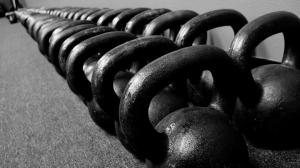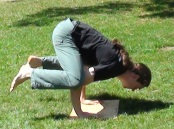Grip Strength and Kettlebell Training- Guest Post by Adam Glass
Big thanks to Adam for writing up this article for me, really great stuff.
I hope you enjoy, apply and benefit!
Check out his site, the links are below.(you will find some massively strong action there!)
Want more grip strength with your KB training?
It’s no secret that kettlebells are useful to increase hand and grip strength.
Maybe you have even experienced some benefits yourself?
Are you interested in getting greater results?
Oh boy another article on grip training! Well pay attention. I am not one of these newbies who just closed their captain of crush #2 for the first time.
My name is Adam Glass. I am 29 years old, I live in Minneapolis. At 6’2” and 218 lbs, I am acknowledged as one of the best grip athletes in my weight class and as having some of the strongest hands on the planet for the things I do. I excel at heavy partial pulls, fatbar lifting, and pinching. I am a certified Captain of Crush, a very good steel bender, and I believe I am the best in the world at tearing decks of poker cards. I teach people to do this kind of stuff. Everyday.
My success is the result of proper training, dedication, and being willing to change things when they were not working. If you are willing to apply yourself, you may find you can do every single one of the things I have done.
Do you know what one of the keys was to my hand strength foundation?
Kettlebell training!
I have been lifting kettlebells for the better part of the last decade. I think they are great, BUT it is not accurate to say kettlebell training alone allowed me to get where I am at now. There had to be some modifications, and that is what this article is about. I don’t want you to stop doing anything, I want you to make a few little changes. They will be high pay off ff you are willing to experiment and do some new things.
Grip Strength and Kettlebell Training
Grip strength is an area of interest with many kettlebell lifters and trainees. Those of you who enjoy high rep sets of snatches and swings know the incredible forearm popping pump that comes with the rapid loading of the tendons from these outstanding total body movements. The primary lifts demand finger endurance and a sustained hook position.
It doesn’t matter if your KB training is centered on endurance or fat loss, you are going to experience the limitations of grip at some point. Maybe it is when you attempt to move on to a heavier bell, or when you look to increase your rep cadence.
So we know this will happen, how can we make this situation better?
I will tell you what will not work well – adding more and more support grip work. That is the most common advise I see passed around when this question comes up. Frankly that advise sucks, and it gets people hurt.
What is the problem?
KB training employs a tightly closed hand position, which grip focused athletes call “support grip” or holding grip. The hand is not moving, the weak point is the strength and endurance of the finger flexors from a fully flexed position. The hand is very strong in this position.
The problem is this is only one of many hand positions and motions of the hand. The only other motion that is commonly used in KB training is an open hand with slight wrist extension at the top of snatches and pressing motions (depending on who teaches you the KB kung fu).
Let me ask you a question; what happens if someone ignore their shoulders and back and only bench presses? That’s right! They become a mullet. Well, that and their posture is terrible. Shoulder pain, rotator cuff pain, mid spine pain. I for one will pass on all of those!
What is wrong there? Too much benching?
NO! The problem is not TOO MUCH. It is TOO LITTLE
Too little rowing. Too little overhead, Too little adduction.
If the trainee adds in those, we find they can typically INCREASE how often they press now as they achieve greater proportionate balance. Amazingly even a moderate amount of movement in the other directions will bring about rapid improvement.
So back to the KB grip. The problem is not actually the tight fist support grip, nor is the solution to do MORE support grip with a closed hand. .
So what can you do? Look at your hand right now, the solution is at the tip of your fingers.
The Basics Of Grip Training
We can look at the structure of the hand and classify exercises according to position and motions.
The first function you use is support grip, which you KB lifters know well.
The fingers and thumb are flexed around an object and held in position. In terms of gross weight moved- support grip is the strongest quality of hand movement which allows the most quantity of weight moved. When you do swings, you are using the support grip.
The next form of the hand is closing, or crush grip
This is what people are doing when they squeeze a torsion gripper such a captain of crush. The crushing strength of the hand is inferior to its gross supporting strength. I will add from examination of my personal training, and the training of other accomplished grip athletes: A powerful crushing grip does not automatically equal a strong support grip. It’s really a specific quality. I know some people who routinely one hand swing 48 kg bells for sets of 25-30 reps without breaking a sweat who struggle to mash a COC #2. They are not weak people, they are simply untrained to that task.
The opposite is true as well – closing tough grippers does not equal exceptional hand endurance…unless the task is closing grippers. It is that specific.
HOWEVER – if you add in some crushing, you will likely find a benefit to your support grip. That is provided you continue to train both characteristics.
Specific to kettlebell trainees, I believe more crushing strength is the lowest pay off for more grip strength. Most people figure out that crush gripping the bell burns out the hands faster, allowing you to do less work. The support grip used in KB training is a softer type of hold. Heavy gripper training in particular is very intensive on the recovery systems of the body and demanding on the tendons. Add in crush grip training at your leisure, but cut back if you find your hands are excessively sore or tired from it.
The third form of the hand uses the forceps power of the thumb in the pinch grip
When we look at pinching, we find dynamic pinching and static pinching. The closing and holding strength of the thumb plays little role to the support grip, especially a closed hand support such as when you hold the kettlebell.
Do you know what that means?
Pinch Training is critical for your hand health!
Back to our bench pressing mullet friend. He is always doing the same motion, he ignores the opposite patterns. He starts having some problems. He then begins to train the balancing movements, and presto he finds not only does he feel better, but his bench begins improving.
A moderate amount of pinch training will be a big pay off for you. The objective here is to make you better with KB’s not turn you in to a grip athlete. You will only need to add in a minimal amount to see a large return.
Ok you sold me, what do I need to do?
I am going to recommend 3 very easy to do pinching movements. Try them out, and do these twice a week after your primary work load. You will not manage too much volume, so take it easy on the reps and load. The key thing here is training the motion which you currently are not getting rather than working towards a huge pull.
Two of these can be done with a hex dumbbell. Hex bells are VERY common, and are actually awesome to have around. The shape of the bells allows you train these two movements which are great for thumb strength.
Two Hands Neutral Grip hex Lift and Two Hands Hex Curl
This is a power house hand strength movement. Very Simple, I know. Simple doesn’t mean ineffective. Very simply – try this out.
One hand plate bouncing
This is a great way to build your dynamic thumb strength, the motion of squeezing the thumb towards the fingers. It also requires very little resistance.
Take a few small plates, try out 3-4 5 lbs plates or 3 – 10 lbs plates and stack them on a platform about waist height. Sandwich them smooth side out and place one hand on top of the stack. Your fingers will be on one side, your thumb on the other. Now pinch them and lift them 1 inch off the platform, then set them down fast and immediately pinch again and lift. Do this over and over. You will be getting many reps per set. The key is the rapid gripping and regripping of the plates.
Do not drop the plates on yourself. Be safe about it.
This will help with my kettlebell training?
Yes it will. Even a moderate amount of thumb training will increase your support grip.
If you could increase hand strength by 15% over the next 4 weeks, how many more reps would you get in your swings and snatches each training day? How would that extra work total up at the end of the next 3 months?
Compounding interest!
Try this out. It will make your hands healthier and stronger. I can tell you one for certain – not a day has past in which I was not finding a use for a stronger grip. I have not had too many situations in life where a 500 lbs squat was the fix, or where a big bench would have helped. I find stronger fingers and thumb make life easier. From pickle jars to cleaning out garages, I am never sorry my hands are strong.
Adam Glass is chief trainer for Movement Minneapolis and competes in both Grip Sport and All-Round weight lifting. He has trained thousands of people to build strong healthy hands. You can learn more about grip training at www.IndustrialStrengthGrip.com and his training blog www.AdamTGlass.com



No comments yet.